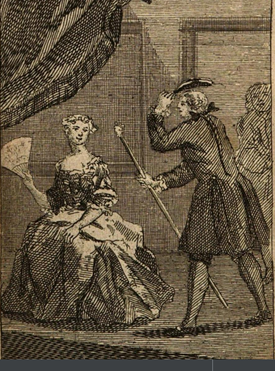Caterina Vizzani (AKA Giovanni Bordoni): A Transgender Life in the 1700s

Transgender issues are nothing new. Ancient Egyptians had gender bending rulers, as did many other ancient cultures. But let us explore an intriguing individual from the 1700s.
Born female in Rome in 1719, Caterina Vizzani lived a short life, dying in Siena at the age of 24 years in June 1743. She was the child of a Milanese woodworker named Pietro Vizzani. Nothing is known of her life until she turned 14, when Caterina learned to read, write and to embroider.
Her first affair with a woman happened at that age, with a fellow embroiderer named Margherita. In order to go out with Margherita, Caterina began dressing as a man, and this relationship carried on happily for 4 years. But all things eventually end — in this case when Margherita’s father learned of the homosexual affair and began to threaten Caterina with reprisals from the city’s authorities. It is worth noting that lesbian affairs were not often subject to legal punishment, but cross-dressing was a serious crime.
It was at this time that Caterina donned men’s clothing full-time, ran away and assumed a male identity as Giovanni Bordoni.
After a brief period of being on the run, Bordoni returned to Rome where he started spending time in the neighbourhood Parish of Santa Maria in Trastevere — this despite still fearing arrest on charges brought forth by Margherita’s father. He told the local priest of his anxiety, explaining that he had had an illicit relationship with a young lady, but he didn’t disclose that he had been a female at the time.
The priest felt sorry for Bordoni and provided him with a refuge. Shortly thereafter a man from Perugia came to the Parish, mentioned that he was seeking a servant. And so Bordoni ended up going to that city in Umbria.
Bordoni was not happy in Perugia. He contacted his mother to ask if she could put in a good word with the priest in Santa Maria in Trastevere. What is interesting to note is that Bordoni’s mother was still quite supportive of her child, despite the change in gender identity. And, based on the biography later written about Bordoni, there is every indication that his father was equally supportive.
To continue, Bordoni wanted the priest to contact the latter’s brother who was the Vicar of Arezzo. By means of various referrals, Bordoni passed through Arezzo and ultimately acquired a steady position in the service of “Cavalier Francesco Maria Pucci of Monte Pulciano”, the Vicar of Anghiari in Toscana.
Pucci was very happy with Bordoni, commenting that the latter was a most capable servant in every way and who never complained about his tasks. It was noted that he was skilled in working with chocolate, in cooking and could write well. The only concern Pucci had pertained to Bordoni’s “libertine” attitude towards women.
Despite his patron’s disapproval, Bordoni was proud of his dalliances. He boasted of his libido, proudly stating that he had caught a venereal disease from cavorting with prostitutes. It is quite possible that he rather cleverly concocted this story to explain away monthly blood stains on his breeches that might be noticed by a laundress. He also bragged of having duelled with a rival for the affections of a young lady — and he had a neck wound to prove it.
Despite ongoing minor scandals, Pucci kept Bordoni in his service for another three or four years, occasionally bringing him along to Montepulciano (Pucci’s native city). Here things become a little unclear. Bordoni was briefly handed off to the governor of Montepulciano, and then returned to Pucci’s service at a place called Ripafratta. Later Pucci brought him to Florence and then back to Montepulciano where Bordoni became embroiled yet more scandals.
It seems that Bordoni was quite the ladies’ man. He was very particular about his appearance and attire. Given to imitating the speech and cadence of the military, he peppered his talk with decisively masculine obscenities. Moreover, he gave himself the appearance of being very well-endowed (he created and wore some sort of strategically placed leather pouch that he stuffed with cloth).
Bordoni was still with Pucci and lived in a hostel where he met another Giovanni who would later become very important to him; it was this man, Giovanni Bianchi, a professor of Anatomy at the University of Siena, who would write Bordoni's biography.
Bigger trouble began brewing in the early 1740s. At this time, Pucci left Bordoni on his own in Ripafratta. It was here that he began courting the niece of the local priest. The two fell “deeply in love”. Bordoni convinced her to run away to Rome with him in order to marry. In June 1743, Bordoni went to collect his future bride at her home, but to his surprise found her younger sister there as well. Apparently, his bride-to-be had divulged their plans to the girl. This young girl said that she too wanted to run away in order to escape the oppressive rules of their uncle, the priest. She threatened to reveal all if they did not take her with them.
With no viable options, Bordoni agreed to bring the younger sister along, despite only having two horses and notwithstanding how this would dangerously slow their journey. The sister followed their horses on foot until they reached Lucca, where they rented a carriage. Then they sped off towards Siena. Unfortunately, just a short distance from the city (at Poggetto), their carriage broke down. Meanwhile, the uncle Priest had put out the word to apprehend the fugitives. The three runaways only managed to reach Staggia where they were intercepted by the priest's posse.
Bordoni considered revealing that he was a biological female — he believed this might lessen the penalties to which he would be subjected. He never had the chance to make that call. A man named Miniato, a family member of the priest, shot Bordoni in the left thigh with an arquebus. It must have been a chaotic scene as Miniato also ended up wounding a small child and killing a large dog in the melee.
Bordoni was brought to the Poggibonsi hospital and then transferred to Santa Maria della Scala in Siena on June 16, 1743. The registry of the hospital noted the admission of “Giovanni Bordoni, age 24, son of Francesco Bordoni [note the name change of the father], of Rome”. Bordoni quickly spotted an associate of Professor Bianchi (whom he had met earlier through Pucci as mentioned above) and asked that he be cared for by the senior doctor and professor. This associate however thought that Bordoni’s case was a minor one and neglected to pass along the request.
His wound was much more serious than the hospital staff thought. Just prior to dying, Bordoni told the attending nun, Sister Maria Colomba Castalda, that he was not a man, but in fact a biological woman.
Later, in his biography of Bordoni, Giovanni Bianchi wrote:
“…he confided [to the nun] that he was a virgin female, and he asked her not to reveal this until after his death when he desired to be dressed in female clothing and have a garland around his head, as was customary in [virgin women’s] funeral services.”
When Bordoni died, he was undressed. The hospital orderlies conducted their own lurid “investigation”, fondling breasts and other body parts, and discovering — to their disappointment — the leather pouch containing rags rather than money.
It was finally revealed that he had been a woman.
A formal autopsy, conducted by Bianchi, confirmed that Bordoni was indeed a virgin as he had claimed. Word got around quickly. The funeral was a crowded affair; far more attended than typically would have done for someone who was merely a servitor.
Caterina Vizzani’s exact burial spot is now unknown, but it was confirmed that she had a proper burial, in consecrated ground, appropriate to a virgin woman.
I hope she got the garland she wanted.
Professor Bianchi was deeply dismayed by the entire sequence of events and was greatly sympathetic towards Caterina. He began gathering information in order to write her biography; he travelled around Toscana and met with many of those who knew Giovanni during their life.
Bianchi’s biography, entitled “Breve storia della vita di Catterina Vizzani”, was published in Florence in 1744. He had to somewhat falsify the account in order to skirt the ecclesiastical censors. He changed some dates, and the locations of certain events were moved to Venice (my guess is that the Church authorities had preferred to obfuscate the clerics involved). In 1751, it was translated into English by John Cleland (the author of “Fanny Hill” and other rather salacious works). Cleland's translation is, for the most part, faithful to the original work in Italian. He does not overly sensationalize as he typically did in other works.
We are fortunate that Bianchi was involved and had such a caring, open-minded nature — well ahead of his time.
Would you like to read other posts? If so, please click the Home Page link below:

You, Dear Reader, are much needed and appreciated.
Everything written requires a reader to make it whole. The writer begins, then you, dear reader, take in the idea and its image, and so become the continuation of its breath. Please subscribe so that my words can breathe. Consider this my hand, reaching out to yours.
